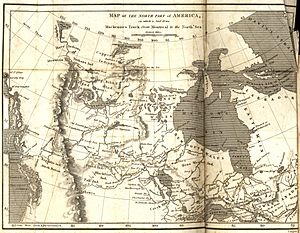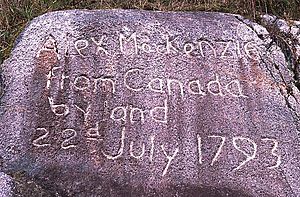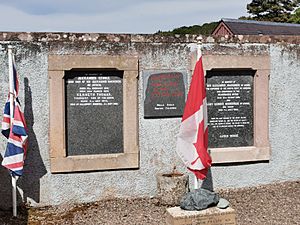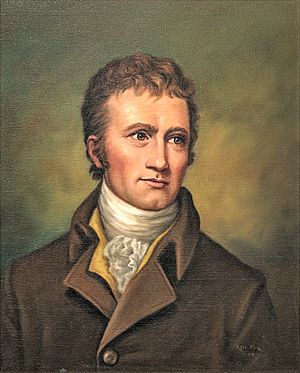Alexander Mackenzie (explorer) facts for kids
Quick facts for kids
Sir Alexander Mackenzie
|
|
|---|---|
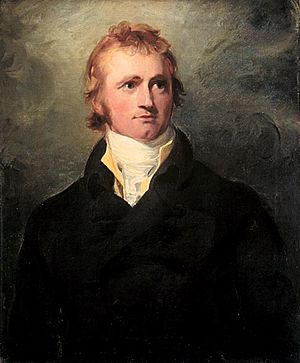 |
|
| Born | c. 1764 |
| Died | 12 March 1820 (aged 55–56) |
| Occupation | Explorer, fur trader |
| Known for |
|
| Signature | |
Sir Alexander Mackenzie (born around 1764 – died March 12, 1820) was a brave Scottish explorer and fur trader. He is famous for being the first person to cross North America by land in 1793. The mighty Mackenzie River in Canada is named after him.
Contents
Early Life and Start in Fur Trading
Alexander Mackenzie was born in Stornoway, a town on the Isle of Lewis in Scotland. When he was about 10 years old, his mother passed away. He then sailed to New York City in 1774 to live with his uncle.
During the American Revolutionary War, a big conflict in America, Alexander's father and uncle joined the army. For his safety, young Alexander was sent to Montreal, a city in Canada, in 1778.
In Montreal, when he was around 15, Alexander began working as an apprentice for Finlay, Gregory & Co. This was a very important company involved in the fur trading business. Fur trading was a huge industry back then, where people traded animal furs for goods. In 1787, his company joined with another big one called the North West Company. This was a major step in his career.
Amazing Explorations
Alexander Mackenzie led two incredible journeys across North America.
The 1789 Arctic Ocean Expedition
In 1788, Alexander Mackenzie helped to establish Fort Chipewyan near Lake Athabasca. This was a trading post for the North West Company. He heard from local First Nations people that the rivers in the area flowed to the northwest. He hoped this would lead him to the Pacific Ocean.
On July 3, 1789, Mackenzie set off by canoe on a large river. The local Dene people called it the Dehcho. Today, we know it as the Mackenzie River. He thought this river would take him to Cook Inlet in Alaska. However, on July 14, he reached the Arctic Ocean instead of the Pacific! He was a bit disappointed because it wasn't the route to the Pacific he had hoped for. He supposedly called it "the River Disappointment," but his own records just called it the "Grand River." Later, the river was named the Mackenzie River in his honour.
The 1792–93 Pacific Ocean Expedition
In 1791, Mackenzie went back to Great Britain to learn more about how to measure longitude. This was important for finding exact locations on maps. He returned to Canada in 1792, determined to find a way to the Pacific Ocean.
On October 10, 1792, Mackenzie left Fort Chipewyan again. He had a small but brave team with him. This included two native guides, his cousin Alexander MacKay, six Canadian voyageurs (skilled canoe paddlers and traders), and even a dog! They traveled along the Pine River to the Peace River. They built a fort there, which they called Fort Fork, and spent the winter.
Mackenzie and his team left Fort Fork on May 9, 1793. They followed the Peace River and crossed the Great Divide. This is a high ridge of mountains that separates rivers flowing to the Pacific from those flowing to the Atlantic or Arctic. They found the upper part of the Fraser River. However, local native people warned them that the Fraser Canyon was too dangerous to travel through.
Instead, they were told to follow a "grease trail." This was a trading path used by native people, often for transporting oolichan oil (a type of fish oil). They followed this advice, climbing over the Coast Mountains and going down the Bella Coola River. Finally, on July 20, 1793, they reached the Pacific coast at Bella Coola, British Columbia. This was a huge achievement!
Mackenzie had completed the first recorded journey across North America north of Mexico. This was 12 years before the famous Lewis and Clark expedition! He had traveled about 4,000 miles. He just missed meeting another famous explorer, George Vancouver, by 48 days.
Mackenzie wanted to keep going out into the open ocean. But the local Heiltsuk people were not friendly. Surrounded by their war canoes, he decided to turn back. Before leaving, he wrote a message on a rock near the water's edge. He used a reddish paint made from a mineral called vermilion and bear grease. The message said: "Alex MacKenzie / from Canada / by land / 22d July 1793." At that time, "Canada" was an informal name for the former French territories in what is now southern Quebec and Ontario.
This spot is now a special place called Sir Alexander Mackenzie Provincial Park. It is recognized as a National Historic Site because it marks the first crossing of North America. In 2016, Mackenzie was named a National Historic Person in Canada.
Later Life and Family
In 1801, the journals from Mackenzie's amazing journeys were published. He was made a knight the next year, which means he was given the title "Sir." He also served in the government of Lower Canada from 1804 to 1808.
In 1812, when he was 48, Mackenzie went back to Scotland. He married Geddes Mackenzie, who was 14 years old. They had two sons and one daughter. They lived between Avoch and London.
Alexander Mackenzie died in 1820 at the age of 56 from a kidney disease called Bright's disease. He is buried in Avoch, Scotland.
Legacy
Sir Alexander Mackenzie left a lasting mark on Canada.
- The Mackenzie River, one of the longest rivers in North America, is named after him.
- Mackenzie Bay and the town of Mackenzie, British Columbia are also named in his honour.
- Several schools across Canada bear his name, including Sir Alexander Mackenzie Senior Public School in Toronto and Sir Alexander Mackenzie Elementary School in Vancouver.
- He is mentioned in the popular 1981 folk song "Northwest Passage" by Stan Rogers.
- A type of rose, the Alexander Mackenzie rose, was developed in 1985 and named after him.
- Between 1989 and 1993, groups tried to re-enact parts of his journey from Montreal to Bella Coola.
Images for kids
See also
 In Spanish: Alexander MacKenzie para niños
In Spanish: Alexander MacKenzie para niños


